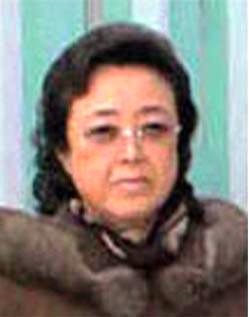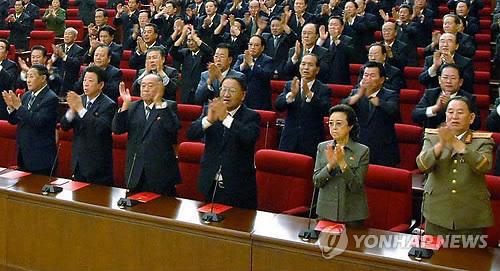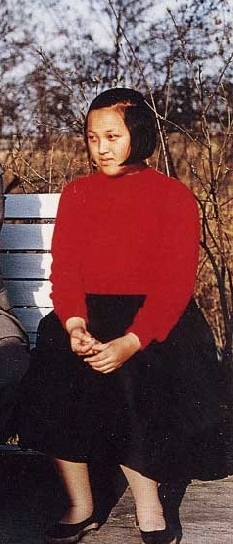Kim Kyong Hui
Biographical Sketch of Kim Kyong-hui
Kim Kyong-hui was born on 30 May 1946 in Pyongyang, the youngest child of the marriage between Kim Il-sung and Kim Jong-suk. She was the only daughter with two sons, Jong-il, born in Khabarovsk, Siberia in 1941, and Pyong-il born in Vyatskoye, Siberia in 1944, and drowned in Pyongyang in July, 1947. (i) From 1946 to 1950, Kim Kyong-hui was raised in Kim Il-sung’s house near Haebang Hill in central Pyongyang, the former home of the Japanese proconsul. Kim Jong-suk passed away in September 1949 delivering a stillborn.
After their mother’s death, Kim Kyong-hui and Kim Jong-il were raised primarily by family members and Kim Il-sung’s personal aides.(ii) Kim Kyong-hui and Kim Jong-il left Pyongyang at the beginning of the Korean War, first to Jagang Province, then Jilin, China. (iii) They returned to Pyongyang in 1952. Between 1951 and 1953, Kim Il-sung married a secretary, Kim Song-ae, who became their step-mother, a relationship Kim Kyong-hui refused to acknowledge.
Kim Kyong-hui entered the Political Economy Department at Kim Il-sung University in 1963. While she attended KISU, she met and began dating Jang Song-thaek, the leader of a student music group. Her uncle who was also chief of the Korean Workers’ Party Organization Department, ordered the university’s president to forbid the couple’s relationship.(iv) Jang Song-thaek was expelled from KISU to the Wonsan University of Economics, however Kim Kyong-hui continued their relationship. They went on to attend the Kim Il-sung School for Higher Party Officials in 1966, and went abroad to study at Moscow State University in 1968. (v)
Kim Kyong-hui began her official career in 1971, with a management position in the Korean Democratic Women’s Union. She married Jang Song-thaek in 1972. In 1975, she became a vice director at the KWP International Department. She was promoted to 1st vice director in 1976.(vi) In 1977, she gave birth to her first child, daughter Jang Kum-song, and around 1979 to her second child, son Jang Kim-song. After her 1976 promotion at the International Department, Kim Kyong-hui is not recorded as holding any official positions until 1985 when she may have headed Office #35.
In 1988 she became department director of the KWP Light Industry Department. In November 1988 she was elected a member of the KWP Central Committee at the 14th plenum of the 6th Party Central Committee. In April 1990 she was elected a deputy (delegate) to the 9th Supreme People’s Assembly. In 1993 she was named department director of the KWP Economic Policy Inspection Department, where the Light Industry and Financial Planning Departments were migrated. When Kim Il-sung passed away in July, 1994, Kim Kyong-hui was ranked #47 on the funeral committee.
In 1997, Kim Kyong-hui was again identified as director of the Light Indutry Department, excised from Economic Policy Inspection. She was elected a deputy (delegate) to the 10th SPA in 1998 and the 11th SPA in 2003. She was last seen in public in a commemorative photograph of the 11th SPA in September 2003. This occurred at the same time as Jang Song-thaek’s hiatus from North Korean public life. In September 2006, their daughter Jang Kum-song passed away in Paris.
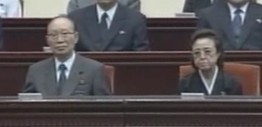
Kim Kyong Hui seated on the rostrum next to CC KWP Control Commission Chairman Kim Kuk Tae at the national meeting on the 15th anniversary of Kim Il Sung's death in July 2009 (Photo: KCTV)
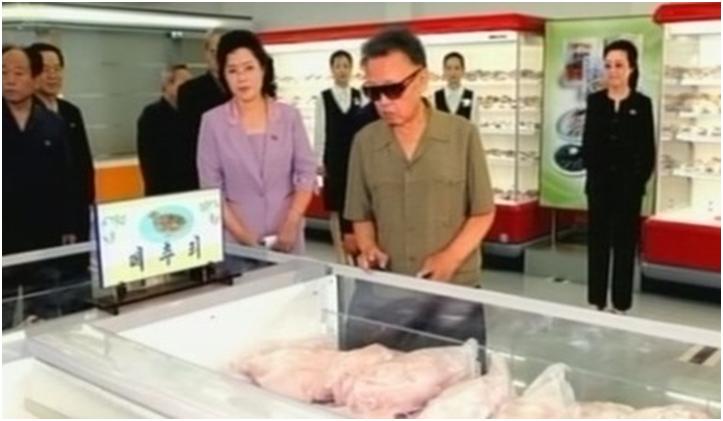
Kim Kyong Hui (R) ttending a vist by her brother to a shop in Pothonggang District, Pyongyang in August 2009 (Photo: KCNA)
Kim Kyong-hui has been a more significant public presence since her return to political life at the 12th SPA in April 2009. For the first time in both the internal and external North Korean press, she was reported to be traveling on Kim Jong-il’s guidance tour of Hamju County, South Hamgyong. This was also the first occasion when she was reported in the company of Jang Song-thaek. In July 2009, she took the rostrum for the 15th anniversary memorial service for Kim Il-sung and listed as #15 in the platform order.(vii) Her reported appearances on guidance tours increased particularly from November to December, 2009.
In 2010 Kim Kyong Hui has regularly accompanied Kim Jong Il on his public appearances. On 28 September 2010, she was given the rank of KPA General, and elected a member of the CC KWP Political Bureau.
Notes about Kim Kyong-hui’s career
Kim Kyong-hui has been at the center of power for nearly 40 years. She has not only been one of her brother’s principle supporters, she has also been one of his central managers and operatives.
- Kim Kyong-hui’s position as Vice Director of the KWP International Department in 1975 occurred when the country established diplomatic relations with the United Nations, Austria, Switzerland, Singapore and Thailand, among others. Kim Kyong-hui, in coordination with Kim Jong-il and Jang Song-thaek, supervised the placement of a second generation of highly educated, multi-lingual diplomatic personnel.(viii)
- From the early 1980s onward, Kim Kyong-hui held several concurrent Party management positions. She was a manger of the business operations of Office #35 (External Investigations) which involved tobacco, narcotics and weapons trafficking to earn income to finance intelligence operations and tithing a portion of its revenue to the Kim Family. From late 1987 she has held the department director’s title at the KWP Light Industry Department. Some companies under the Light Industry Department are tied to the DPRK’s illicit business operations including narcotics, counterfeiting and cigarette smuggling.
- Kim Kyong-hui supervised the merger of the KWP Financial Planning and Light Industry Department into the Economic Policy Inspection Department in the early 1990’s. This occurred at the same time the North Korean economy was beginning its tailspin. Amid the specter of the Arduous March, the country officially transitioned from KIS to KJI. In a pure exercise of his power (and to highlight scapegoats for the economic problems), KJI began a system of inspections of the country’s factories.
Kim Kyong-hui in her official capacity as director of Economic Policy Inspections and in the unofficial capacity as one of her brother’s political managers participated in inspections of factories that resulted in the incarceration or public execution of local Party and economics officials.(ix)
- Kim Kyong-hui has numerous personal and political friends among her brother’s cohorts including SPA President Kim Yong-nam, KWP Secretaries Choe Thae-bok and Kim Ki-nam, MOFA Vice-Minister Kang Sok-ju and United Front Department Director Kim Yang-gon. She was also close to the late KWP International Secretary Kim Yong-sun. Among Kim Jong-il’s personal retinue, she is particularly close to Ri Chang-son and Ko Yong Hui. The nature of her relationship to Kim Ok is not clear. Kim Ok’s younger sister was said to be present at the time Jang Kum-song (KKH’s daughter) died in Paris.
For three decades she has attended KJI’s banquets and parties, a superficial indication of social and political prominence in Pyongyang. Actress Choi Eun Hee dined and attended parties with Kim Kyong-hui and Jang Song-thaek in the 1970s and 1980s. Kenji Fujimoto recalled the constant presence of Ms. Kim and Mr. Jang in the 1980’s and 1990’s. (x)
Kim Kyong-hui has also been her brother’s personal representative to extended members of the Kim and Kang Family, as well as to elites from other favored Revolutionary families. The nature of her relationships with individual personalities is not clear, and it is likely that they are not all cordial. She has also had the sensitive task of attending to her brother’s personal life. She coordinated Kim Jong-nam’s move to Switzerland in the early 1980’s, and told his mother Song Hye-rim that Ms. Song was to be exiled.(xi)
- Kim Kyong-hui’s first reported appearance at the Tongbong Cooperative Farm in early June 2009 was the first reported occasion when she appeared on one of KJI’s guidance tours.(xii) Ms. Kim’s initial appearance was taken as an indication that the Kim Family had reached a consensus on the hereditary succession of youngest son Kim Jong-un. Other observers interpreted her appearance to indicate that KJI was creating an image of relying on his family members after his August 2008 stroke.(xiii)
- Kim Kyong-hui made 18 reported or observed appearances in 2009. The number of her appearance rose dramatically in December. As she is officially identified as a KWP economics official (Director of the Light Industry Department), it is likely the increase in her appearances are correlated to the country’s currency redenomination which occurred a week prior to the increase in her appearances.

Kim is 6th R and her husband 4th L in this commemorative photograph taking during a visit to the Migok Cooperative Farm in North Hwanghae Province in 2009 (Photo: KCNA)
- In November 2009 a report appeared in JoongAng Ilbo that attempted to account for Kim Kyong-hui’s increasing presence in DPRK public life. This report alleged that KJI’s previous technical secretary, Kim Ok left her job in the Personal Secretariat.(xiv) Kim Ok’s previous responsibilities were undertaken in part by his sister. An ROK official told JoongAng Ilbo:
With Kim Ok out of the picture, we’re instead focusing on the increased activities for Kim Kyong-hui, Kim Jong-il’s younger sister and a director at the Workers’ Party. It’s possible that the intelligence on Kim Ok’s marriage is related to Kim Kyong-hui’s emergence into the spotlight.
- On 7 February 2010, Kim Kyong-hui was reported to have attended a performance of the Russian opera Evgeni Onegin along with KJI, Jang Song-thaek, KWP Secretaries Choe Thae-bok and Kim Ki-nam and a delegation from the Russian Federation Embassy in Pyongyang including Ambassador Valery Sukhinin and his wife. This was the first reported appearance of Kim Kyong-hui and her husband interacting with a foreign delegation.
- On 11 February 2010 Chosun Ilbo published a report on Kim Kyong-hui’s public profile and likely influence in KJI’s inner circle.XV This report cited Jang Song-thaek’s and her role as possible political executors for a post-KJI North Korea:
Kim Jong-il apparently believes that his family will not stand in the way of his third son succeeding to the leadership. There is also speculation that he is traveling with his sister and her husband to prevent possible controversy over the authenticity of his wishes if he suddenly dies or loses consciousness.
If something happens to Kim Jong-il, it would be inevitable for the North Korean leadership to rule according to his last wishes, because heir apparent Kim Jong-un,who is in his mid-20s, is considered too young to take power and thus his succession could lead to a power struggle. The source said, “There would be no controversy over the authenticity of his last wishes if two members of his family claim they have heard them.”
- On 17 February 2010 Yonhap reported of Kim Kyong-hui’s inclusion on ROK Ministry of Unification flow charts illustrating power relationships in the country. (xvi)
- As of August 2010, Kim Kyong-hui was the most frequent member of her brother’s retinue.
i. See Suh, Dae-Sook Kim Il-sung: The North Korean Leader New York: Columbia University Press,
1995.
ii. Kim Kyong-hui and Kim Jong-il were attended to by Hong Ki-yon, Kim Song-ae, KIS bodyguard Ri Ul-sol and paternal uncle Kim Yong-ju.
iii. See Lim, Jae-Cheon. Kim Jong Il’s Leadership of North Korea London: Routledge, 2009
iv. Hwang, Jang-yop. Na nun yoksa ui chilli rul poatta : Hwang Chang-yop hoegorok. Seoul: Hanul, 1999.
v. See Madden, Michael. “A Biography of Jang Song-thaek: the Juche Jump (Hey, Mr. Jang!)” in Parallax: Journal of International Perspectives (Volume VI, No.1 Fall 2009) Boston: Suffolk University, 2009.
vi. Kim Kyong-hui’s promotion to 1st Vice Director of the KWP International Department occurred at the same time KJI took control of the Central Party around 1976.
vii. See “Power shifting in Pyongyang?” Northeast Asia Matters. 15 October 2009 (http://asiamatters.blogspot.com/2009/10/power-shifting-in-pyongyang.html)
viii. Among the diplomatic personnel assigned to the Ministry of Foreign Affairs or DPRK Embassies abroad are current MOFA Vice Ministers Kim Kye-gwan (representative to the Six Party Talks) and Kang Sok-ju, as well as KWP International Department Director Kim Yong-il (assigned between December 2009 and January 2010).
ix. See pp. 190-193 in Becker, Jasper. Rogue Regime: Kim Jong Il and the Looming Threat of North Korea. Oxford: Oxford University Press, 2006.
x. Baird, Merrily. Kim Chong-il Agonistes. (forthcoming)
xi. See Hwang, Jang-yop (op.cit.) and Song, Hye-rang. Tungnamu chip. Seoul: Chisik Nara, 2000.
xii. “North Korean Leader Accompanied By Sister During Public Tour” Yonhap News Agency, 7 June 2009
xiii. See Gause, Ken. “Future North Korean Crises: Scenarios and Signposts.” Alexandria, VA: Center for Naval Analyses, June 2009.
xiv. “Kim Jong-il’s Mistress May Have New Lover,” Jeong Yong-soo, JoonAng Daily, 23 November 2009
xv. “North Korea’s 1st Family Pulls Closer,” Choson Ilbo, 11 February 2010
xvi. “North Korean Leader Sister’s Seen to Have Growing Power,” Yonhap News Agency, 17 February 2010
